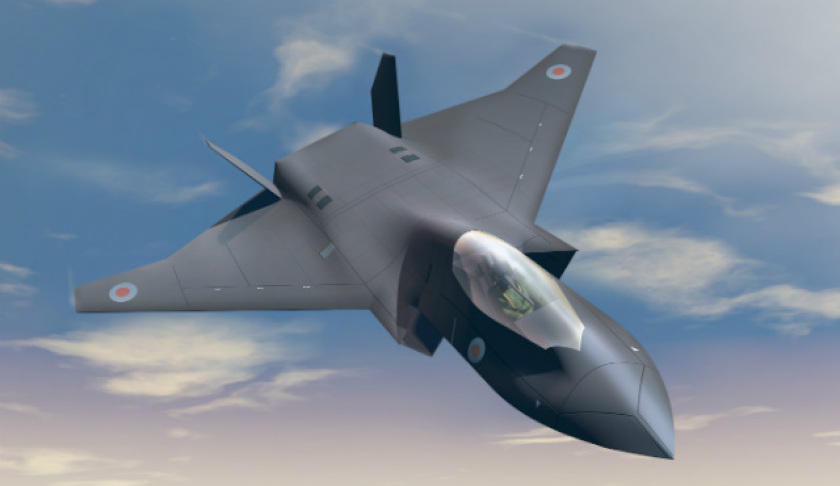The UK government and Royal Air Force have used the 2018 Farnborough International Air Show to launch the Combat Air Strategy and officially unveil BAE’s vision for the next generation of the UK’s combat air capability, the Tempest.
To continue reading the rest of this article, please log in.
Create free account to get unlimited news articles and more!
As the global air combat trends continue to evolve and the strategic environment becomes increasingly complex, the UK government and RAF identified the need for its future air combat capabilities to operate effectively in congested, contested and complex environments, where speed and agility are essential for mission success.
Building on the success of the Eurofighter Typhoon, developed in conjunction with Germany, Italy and Spain and now in operation with air forces throughout Europe and the Middle East, the UK government, Ministry of Defence, RAF and BAE have combined the lessons learned throughout the research and development, procurement and operational phases of the Typhoon project to prepare the nation and industry for the next generation of air combat capability.
The Tempest project will see industrial co-operation and collaboration between some of the largest and most advanced aerospace and defence companies in the world to deliver an unrivalled air combat capability for the RAF, including:
- BAE Systems – advanced combat air systems and integration;
- Rolls-Royce – advanced power and propulsion systems;
- Leonardo – advanced sensors, electronics and avionics; and
- MBDA – advanced weapons systems.
These key industry partners aim to deliver an air combat system which is capable, flexible, upgradeable, connected and affordable to ensure that the system is capable of operating in the future battlespace.
Capable: All of the partners agree that a future combat air system must be able to survive the most challenging combat environments, meaning that payload-range, speed and mannoeuvrability will be key to operational success. It is also expected that the Tempest system would be equipped with a suite of sensors including radio frequency, active and passive electro-opitcal sensors and advanced electronic support measures and counter measures to support threat detection and interception.
Developments in directed energy weapons systems will also provide for self-defence and use within visual range aerial combat, while the ability to deploy and manage swarms of air launched UAVs will provide an unprecedented lethality and response to anti-access area denial strategies currently employed by potential adversaries.
Flexible: Adaptability will be built into the system design, with systems architectures that support a ‘plug and play’ approach, easily integrating new algorithms and hardware. Depending on the mission, ‘role fit’ additions such as low observable conformal fuel tanks, weapons dispensers, air launched UAV dispensers, large modular sensors, long range oblique photography systems for reconnaissance and laser directed energy weapons could be available.
The aircraft would require that these features are dynamically reconfigurable and serve to enhance survivability, availability, cyber resilience and tactical options.
Connected: Leveraging information and data gathering enables commanders and individuals to make informed decisions in complex, stressful environments, while also increasing the force multiplier effects of interoperability with a wide range of other civil and military platforms and services across air, land, sea, space and cyber domains, as well as unmanned systems.
Command and control of other systems, such as UAVs, will be enabled from a fully customisable virtual cockpit, with advanced human-machine interfaces, including eye tracking and gesture based controls, offering intuitive and sophisticated mission management.
Upgradeable: The Tempest will need to be quickly and affordably upgradeable. This means physical interfaces must be strong, lightweight, numerous and affordably produced. This will be achieved through industry expertise in additive layer manufacturing, joining and fastener technology, ‘geometric locking’, and low observable materials.
Affordable: Advanced manufacturing techniques will play a significant role in reducing the unit production cost of Tempest, and will be a key enabler of ensuring system flexibility and upgradeability. Automated manufacturing, maintenance and support infrastructure can reduce in-service support costs by leveraging the research and development and implemention of such equipment in earlier models to assist in the re-arming, re-fuelling, specialist role-customisation and repair spaces.
Additionally, affordable pilot and air crew training costs can be supported through the integrated use of artificial intelligence, data analytics and complex flight simulators to minimise the burden on all involved.
It is anticipated that the UK, in conjunction with it's industry partners, will deliver the Tempest next generation air combat capability by 2035 to operate in conjunction with the RAF F-35s and the later tranche of Eurofighter Typhoons, which they will eventually replace.
The announcement of the capability comes just weeks after Japan formally kicked off it's own fifth-generation fighter jet competition, which has attracted global industry interest from primes including Lockheed Martin, Northrop Grumman, Boeing and BAE Systems, and European powerhouses France and Germany revealing their own next generation air combat project, which will replace the Panavia Tornado and Dassault Rafale beginning in the 2030s.
Stephen Kuper
Steve has an extensive career across government, defence industry and advocacy, having previously worked for cabinet ministers at both Federal and State levels.

 Login
Login








